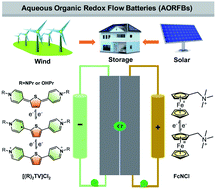Thienoviologen anolytes for aqueous organic redox flow batteries with simultaneously enhanced capacity utilization and capacity retention†
Abstract
A series of thienoviologen derivatives ([(NPr)2TV]Cl4 and [(OHPr)2TV]Cl2) with a narrow bandgap, high solubility and two-electron transfer properties as anolytes for high-performance aqueous organic redox flow batteries (AORFBs) is reported. Compared with [(OHPr)2TV]Cl2 and other viologen anolytes, [(NPr)2TV]Cl4 showed a higher diffusion coefficient (D, 3.36 × 10−6 cm2 s−1) and electron transfer constant (k0, 0.31 cm s−1). Paired with (ferrocenylmethyl)-trimethylammonium chloride (FcNCl) as the catholyte, the specific capacity of the [(NPr)2TV]Cl4/FcNCl AORFB reached 4.62 A h L−1, and the capacity utilization was up to 86.1%. Moreover, the system also maintained high stability over 300 cycles and delivered 87.9% capacity retention and 99.96% capacity retention per cycle. The simultaneously enhanced capacity retention and capacity utilization of [(NPr)2TV]Cl4-based AORFBs were attributed to the high D and k0, resulting from the smaller molecular volume (583.38 Å3) and appropriate dihedral angle (∼18.37°) between the pyridines.



 Please wait while we load your content...
Please wait while we load your content...